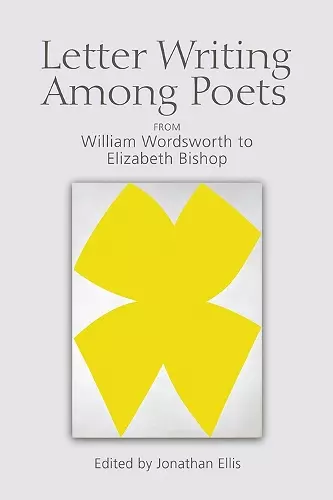Letter Writing Among Poets
From William Wordsworth to Elizabeth Bishop
Format:Hardback
Publisher:Edinburgh University Press
Published:13th Jan '15
Currently unavailable, and unfortunately no date known when it will be back

The first book to look at poets’ letters seriously as an art form Fifteen enlightening chapters by leading international biographers, critics and poets examine letter writing among poets in the last two hundred years. They range from Coleridge, Wordsworth, Keats and Shelley in the nineteenth-century to Eliot, Yeats, Bishop and Larkin in the twentieth. In doing so, they respond to the following questions. Who are the great letter writers of the past? Why is reading other people’s mail so addictive? What is the relationship between letter writing and other literary genres such as poetry? Divided into three sections—Contexts and Issues, Romantic and Victorian Letter Writing, and Twentieth-Century Letter Writing—the volume demonstrates that real letters still have an allure that virtual post struggles to replicate. Key Features: A comprehensive collection of essays on the art and genre of letter writing among Romantic, Victorian and Twentieth Century poetsContributors are leading international biographers, critics and poets, including Hermione Lee, Paul Muldoon, Daniel Karlin, Hugh Haughton, Anne Fadiman, Edna Longley and Angela LeightonAn absorbing history of literary friendship, literary love, and literary rivalryA sensitive study of the often close relationship between letter writing and poetry
This much needed and very welcome work does two important things: It gives us all of Mansfield’s fiction, with useful notes; and it removes many of John Middleton Murry’s intrusions into the stories he edited after Mansfield’s death. We all owe the editors, Gerri Kimber and Vincent O’Sullivan, a debt of gratitude for this excellent edition of the work of a major modernist writer. -- Professor Robert Scholes, Brown University
Letters---that thoroughly familiar yet under-studied form of writing, always ancillary and yet essential to literary understanding. They blur the boundaries between ordinary experience and art, improvisation and convention, individual expression and collaboration. Somehow they matter especially for poets and poetry. With speculative force, nuanced interpretation, and lively narrative too, the various essays in this book, the only one of its kind, begin to answer the question (important to poetry and letters both) of why. Langdon Hammer, Yale University * Langdon Hammer, Yale University *
The collection looks backwards rather than forwards, celebrating the productive hybridity of letters as 'not only a source of information but a form of information'; letters are taken seriously as an art form in their own right, rather than a secondary source the critic mines for insights. Central to the collection is the shared conviction that letters are not 'autobiography by another name' but rather 'performances'... Covering the Romantic period through to the twentieth century, the volume addresses a miscellany of subjects, although Keats and Bishop are, rightly, important touchstones... the essays are penetrating and engagingly written. -- Ruth Hawthorn * PN Review *
To read poets' letters to other poets is to gain insight into the context in which they operated and into the complex bond of common obsession and lonely practice that ties and at the same time separates them. It also, of course, casts light on the work itself. -- Peter Sirr * Poetry Ireland Review *
The fifteen essays in this volume consider letters written during the past two centuries, and shed light on the state of correspondence today. The editor, Jonathan Ellis, offers a gentle admonition to critics who mourn the 'lost world' before the internet (in the words of Rebecca Solnit), a time when everyone wrote at length and thought in depth... The scholarly contributors to Letter Writing Among Poets argue that letters merit as much critical attention as texts in other genres, and that poets' letters reward particular scrutiny. A letter may offer explicit commentary on individual poems or poetics, as does one written by Keats on December 27, 1817, explaining his concept of negative capability. Others, such as those exchanged by Coleridge and his contemporaries, contain gossip that provides insight into the way literary networks operated. Every letter exemplifies its writer’s literary style, while some can be a testing ground for poetry. -- Nancy Campbell * Times Literary Supplement *
ISBN: 9780748681327
Dimensions: unknown
Weight: unknown
272 pages